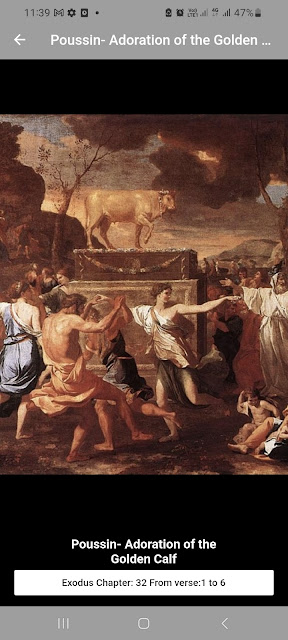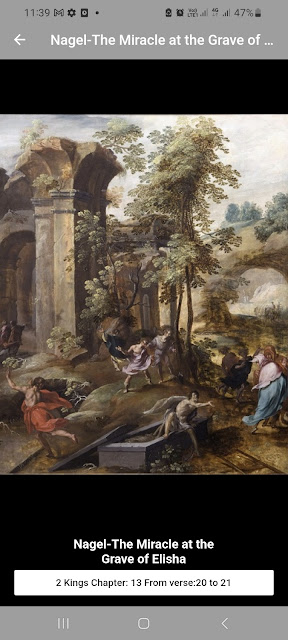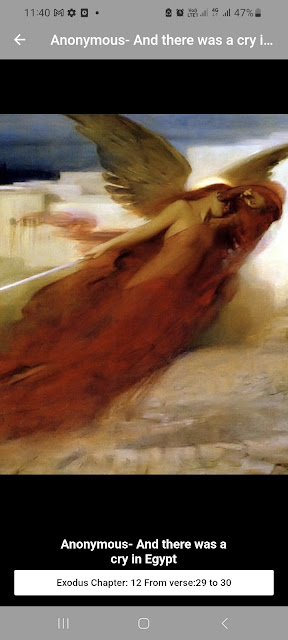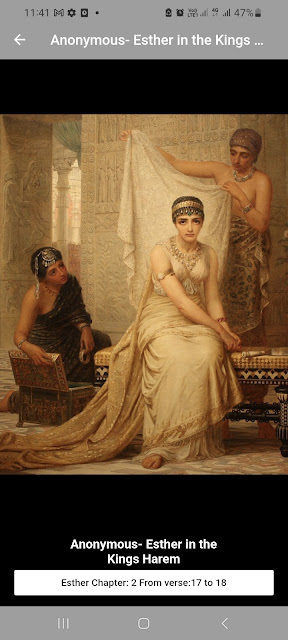Our Bible Verse wallpaper hd app has about 1,000 famous works for your enjoyment. We expound on a few paintings in our gallery, but you can see much more in the app.
a) The miracle at the grave of Elisha 2 Kings 13: 20-21
The "Miracle at the Grave of Elisha" is recorded in 2 Kings 13:20-21, which states: "Elisha died and was buried. Now Moabite raiders used to enter the country every spring. Once while some Israelites were burying a man, suddenly they saw a band of raiders; so they threw the man's body into Elisha's tomb. When the body touched Elisha's bones, the man came to life and stood up on his feet." The body was thrown into the tomb, probably in order to protect the body from being captured or desecrated. When the body touched Elisha's bones, the dead man came back to life and stood up.
b) Moses and the 10 commandments Exodus 13: 14-18
b) Moses and the 10 commandments Exodus 13: 14-18
This painting shows the story of Moses and the Ten Commandments, which is a central event in the Hebrew Bible and is recorded in Exodus 20:1-17. According to the account, after the Israelites escaped from slavery in Egypt, God delivered the Ten Commandments to Moses on Mount Sinai. The commandments were given to the Israelites as a way to guide their behaviour and help them live in a way that honoured God and showed love and respect for one another.
The Ten Commandments are as follows:
You shall have no other gods before me.You shall not make for yourself an idol.You shall not misuse the name of the Lord your God.Remember the Sabbath day, to keep it holy.Honour your father and your mother.You shall not murder.You shall not commit adultery.You shall not steal.You shall not give false testimony against your neighbour.You shall not covet your neighbour's house, wife, or possessions.These commandments provide a framework for living a virtuous and holy life and address a range of ethical and moral issues, including the worship of God, the treatment of others, and the importance of telling the truth.
The Ten Commandments continue to be significant to many people today, both within and outside of the Jewish and Christian traditions. They are seen as universal moral principles that provide guidance for how people should treat one another and live in a just and loving society. The story of Moses and the Ten Commandments serves as a powerful reminder of the role that God plays in the lives of His people and the importance of following His commands.
c) Adoration of the Golden calf Exodus 32: 1-6

The Ten Commandments are as follows:
You shall have no other gods before me.
You shall not make for yourself an idol.
You shall not misuse the name of the Lord your God.
Remember the Sabbath day, to keep it holy.
Honour your father and your mother.
You shall not murder.
You shall not commit adultery.
You shall not steal.
You shall not give false testimony against your neighbour.
You shall not covet your neighbour's house, wife, or possessions.
These commandments provide a framework for living a virtuous and holy life and address a range of ethical and moral issues, including the worship of God, the treatment of others, and the importance of telling the truth.
The Ten Commandments continue to be significant to many people today, both within and outside of the Jewish and Christian traditions. They are seen as universal moral principles that provide guidance for how people should treat one another and live in a just and loving society. The story of Moses and the Ten Commandments serves as a powerful reminder of the role that God plays in the lives of His people and the importance of following His commands.
c) Adoration of the Golden calf Exodus 32: 1-6
The painting shows the story of the Adoration of the Golden Calf as recorded in Exodus 32:1-6 and is a significant event in the history of the Israelites. According to the account, after Moses had gone up Mount Sinai to receive the Ten Commandments from God, the Israelites became anxious about his long absence and asked Aaron, Moses' brother, to make a god for them. Aaron collected the golden earrings of the people and melted them down to make a golden calf, which the people then worshipped as their god.
This event is seen as a clear violation of the first commandment, which stated that the Israelites should have no other gods before the Lord. The worship of the golden calf represented a turning away from God and a rejection of the covenant that He had made with the Israelites.
When Moses returned from Mount Sinai and saw what had happened, he was greatly troubled. He broke the tablets containing the Ten Commandments and then descended from the mountain to confront the people. After speaking with God, Moses went back up the mountain to receive a new set of tablets and to receive further instructions from God.
d) Moses smashing the tablets Exodus 31: 14-18
The painting shows the story of the Adoration of the Golden Calf as recorded in Exodus 32:1-6 and is a significant event in the history of the Israelites. According to the account, after Moses had gone up Mount Sinai to receive the Ten Commandments from God, the Israelites became anxious about his long absence and asked Aaron, Moses' brother, to make a god for them. Aaron collected the golden earrings of the people and melted them down to make a golden calf, which the people then worshipped as their god.
This event is seen as a clear violation of the first commandment, which stated that the Israelites should have no other gods before the Lord. The worship of the golden calf represented a turning away from God and a rejection of the covenant that He had made with the Israelites.
When Moses returned from Mount Sinai and saw what had happened, he was greatly troubled. He broke the tablets containing the Ten Commandments and then descended from the mountain to confront the people. After speaking with God, Moses went back up the mountain to receive a new set of tablets and to receive further instructions from God.
d) Moses smashing the tablets Exodus 31: 14-18
View more Images here
The story of Moses smashing the tablets is recorded in the book of Exodus, chapter 31, verses 14-18. According to the Bible, after Moses received the Ten Commandments from God on Mount Sinai, he descended the mountain and saw that the Israelites had made a golden calf and were worshiping it. In his anger, Moses threw down the tablets and broke them.
View more Images here
The story of Moses smashing the tablets is recorded in the book of Exodus, chapter 31, verses 14-18. According to the Bible, after Moses received the Ten Commandments from God on Mount Sinai, he descended the mountain and saw that the Israelites had made a golden calf and were worshiping it. In his anger, Moses threw down the tablets and broke them.
The breaking of the tablets is often seen as a symbol of the Israelites' broken covenant with God. The Ten Commandments were meant to be a reminder of God's laws and the conditions of their covenant with him, and by breaking the tablets, the Israelites were essentially breaking that covenant.
Some interpretations of this event suggest that Moses broke the tablets in order to show the Israelites the seriousness of their sin and the gravity of breaking the covenant with God. By breaking the tablets, Moses was demonstrating that the laws of God were not to be taken lightly and that the consequences of breaking them were severe.
Others see the event as a moment of frustration and disappointment on Moses' part, as he had just received the tablets from God and was devastated to see the Israelites so quickly breaking the covenant. In this interpretation, the breaking of the tablets represents Moses' disappointment and anger at the Israelites' disobedience.
e) And there was a cry in Egypt Ex 12: 29-30
The breaking of the tablets is often seen as a symbol of the Israelites' broken covenant with God. The Ten Commandments were meant to be a reminder of God's laws and the conditions of their covenant with him, and by breaking the tablets, the Israelites were essentially breaking that covenant.
Some interpretations of this event suggest that Moses broke the tablets in order to show the Israelites the seriousness of their sin and the gravity of breaking the covenant with God. By breaking the tablets, Moses was demonstrating that the laws of God were not to be taken lightly and that the consequences of breaking them were severe.
Others see the event as a moment of frustration and disappointment on Moses' part, as he had just received the tablets from God and was devastated to see the Israelites so quickly breaking the covenant. In this interpretation, the breaking of the tablets represents Moses' disappointment and anger at the Israelites' disobedience.
e) And there was a cry in Egypt Ex 12: 29-30
The "cry in Egypt" is a reference to the final plague that God inflicted upon the Egyptians before the Israelites were released from slavery. This event is recorded in Exodus 12:29-30.
According to the Bible, after the death of the firstborn in every household, Pharaoh finally relented and allowed the Israelites to leave Egypt. As they were departing, Pharaoh changed his mind and pursued the Israelites with his army. In response, God caused the Red Sea to part, allowing the Israelites to cross to the other side while the Egyptians drowned when the sea closed again.
The "cry in Egypt" mentioned in these verses is likely a reference to the lamentation and mourning that would have taken place as a result of the death of the firstborn and the drowning of the Egyptian army. The text describes the cry as being "great," which suggests that it was a widespread and intense outpouring of grief and sorrow.
In biblical and historical context, the "cry in Egypt" serves as a reminder of the power and sovereignty of God, who can bring judgment upon those who oppose him, but also show mercy and deliverance to his people.
f) Esther in the Kings harem Esther 2:17-18
According to the Bible, after the death of the firstborn in every household, Pharaoh finally relented and allowed the Israelites to leave Egypt. As they were departing, Pharaoh changed his mind and pursued the Israelites with his army. In response, God caused the Red Sea to part, allowing the Israelites to cross to the other side while the Egyptians drowned when the sea closed again.
The "cry in Egypt" mentioned in these verses is likely a reference to the lamentation and mourning that would have taken place as a result of the death of the firstborn and the drowning of the Egyptian army. The text describes the cry as being "great," which suggests that it was a widespread and intense outpouring of grief and sorrow.
In biblical and historical context, the "cry in Egypt" serves as a reminder of the power and sovereignty of God, who can bring judgment upon those who oppose him, but also show mercy and deliverance to his people.
f) Esther in the Kings harem Esther 2:17-18
The story of Esther in King Ahasuerus' harem is described in the book of Esther, chapter 2, verses 17-18. According to the Bible, Esther was a young Jewish woman who lived in Persia during the reign of King Ahasuerus. She was chosen by the king to become part of his harem, along with many other beautiful women, as part of his search for a new queen.
Esther was taken to the king's palace and was given a complete makeover, including beauty treatments and new clothing, to prepare her for her role in the harem. In these verses, the text describes Esther as finding favor in the eyes of King Ahasuerus, which likely refers to her beauty and charm, as well as her good character and demeanour. This favor would play a critical role in the events that followed, as Esther would later be chosen by the king to become his queen and would use her influence to save her people from destruction.
g) Dream of Solomon 1 Kings 3: 1-15
The story of Esther in King Ahasuerus' harem is described in the book of Esther, chapter 2, verses 17-18. According to the Bible, Esther was a young Jewish woman who lived in Persia during the reign of King Ahasuerus. She was chosen by the king to become part of his harem, along with many other beautiful women, as part of his search for a new queen.
Esther was taken to the king's palace and was given a complete makeover, including beauty treatments and new clothing, to prepare her for her role in the harem. In these verses, the text describes Esther as finding favor in the eyes of King Ahasuerus, which likely refers to her beauty and charm, as well as her good character and demeanour. This favor would play a critical role in the events that followed, as Esther would later be chosen by the king to become his queen and would use her influence to save her people from destruction.
g) Dream of Solomon 1 Kings 3: 1-15
The dream of King Solomon is described in 1 Kings 3:1-15. According to the Bible, Solomon was a young king who had just taken the throne and was seeking guidance from God on how to rule justly and wisely. In his dream, God appeared to Solomon and offered to give him anything he desired.
Solomon asked for an understanding heart so that he could discern right from wrong and judge his people fairly. God was pleased with this request and granted it, but also added wisdom, wealth, and honour to his kingdom.
The dream of Solomon is significant because it demonstrates the king's humility and devotion to God. Rather than asking for power, wealth, or fame, Solomon asked for the ability to rule justly and serve his people. This request pleased God, who saw that Solomon had a wise and humble heart.
In addition to demonstrating Solomon's character, the dream also highlights the importance of wisdom and discernment in leadership. As a ruler, Solomon needed to make many difficult decisions, and his request for an understanding heart suggests that he recognized the importance of seeking God's wisdom in his rule.
Enjoy
Solomon asked for an understanding heart so that he could discern right from wrong and judge his people fairly. God was pleased with this request and granted it, but also added wisdom, wealth, and honour to his kingdom.
The dream of Solomon is significant because it demonstrates the king's humility and devotion to God. Rather than asking for power, wealth, or fame, Solomon asked for the ability to rule justly and serve his people. This request pleased God, who saw that Solomon had a wise and humble heart.
In addition to demonstrating Solomon's character, the dream also highlights the importance of wisdom and discernment in leadership. As a ruler, Solomon needed to make many difficult decisions, and his request for an understanding heart suggests that he recognized the importance of seeking God's wisdom in his rule.
Enjoy





